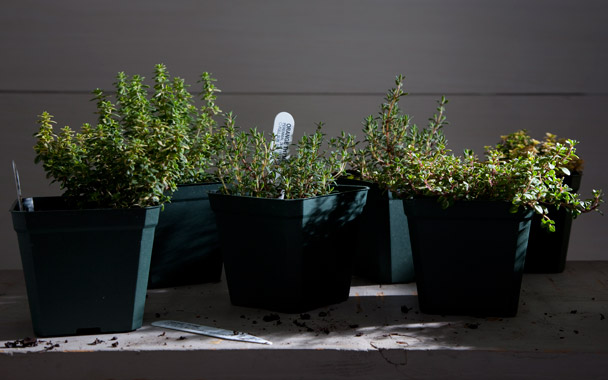The other day I received what I’ve come to think of as a typical email from Gourmet travel editor Bill Sertl—there was no subject line, no text whatsoever, just a photograph of what appeared to be a freshly painted Pepto-Bismol–pink bookcase lying in a driveway. To call Sertl (as he’s almost universally known among friends and coworkers) a man with obsessions is somewhat like calling Joan Crawford’s Mildred Pierce a nice gal with a diner. So when he revealed that it was not a bookcase but a frame for a raised herb bed that he and his partner are installing at their home on Long Island’s North Fork, I could already envision it in August, the basil overflowing the wildly pink slats until it finally spilled all the way down the hill to the Peconic Bay. I could also imagine Sertl using his bumper crop as an excuse to make a bottomless batch of pesto (maybe to accompany a bottomless pitcher of mint juleps he’d made from another runaway planting). Travel editors know how to live.
I can’t really blame him. When it comes to herbs I share my friend’s obsession, especially when it comes to basil and thyme. It’s still a bit early here in the Northeast to put basil in the soil, but thyme is as rugged as it is versatile. Sertl was poised to plant it this past weekend (along with other hearty herbs including oregano, sage, tarragon, and dill), as were Stephen and I. We added four varieties to our herb bed: For cooking we put in English, or common, thyme (Thymus vulgaris) and lemon-scented Thymus citriodorus. To simply flower and creep along the fieldstones in our garden path we added silver-edged Thymus vulgaris ‘Argenteus’ and the variegated ‘Archer’s Gold,’ which smell like heaven when they get slightly crushed underfoot. It’s important to choose the right variety. (Last year we made the mistake of planting a creeping thyme that, while beautifully scented, was a bust in the kitchen.) For cooking, also try a fragrant vulgaris ‘Provencal’ or a sweet orange Thymus fragrantissimus. And remember to pick the leaves for cooking just before the plant flowers (otherwise the flavor is less piquant).
If you feel you don’t have much of a green thumb, thyme is one of those plants that will make you think otherwise: It requires little water (it likes a dry, sandy soil) and little care, other than plenty of sunshine. It’s perennial, and the bush varieties of thyme (but not the creeping or climbing types) often seed themselves.
I fell in love with thyme while living in Brooklyn, where I used to pop into a vest-pocket-sized Moroccan restaurant for a baked pita topped with za’atar, a heady seasoning of sesame, thyme, ground sumac, and salt. (In Arabic, za’atar means “wild thyme.”) Food editor Maggie Ruggiero, a wild cook with a few obsessions of her own, says she adores cooking with thyme because its many varieties can swing savory (in meat dishes such as an herb-roasted pork loin) or sweet (as in her panna cotta with lemon-thyme peaches) or in her fellow food editor Ian Knauer’s thyme-maple cream biscuits.
You might also want some thyme around if you have bronchitis. According to the info- and recipe-packed magazine The Herb Companion, thyme acts as an antimicrobial and antispasmodic, especially for the bronchi, and makes a healing tea. It’s a prime component in several cough medicines and even shows up in the goopy Vicks VapoRub that I slather on to kick a chest cold. Could thyme be the perfect herb?
All I know is that between my garden and Sertl’s Jayne Mansfield–pink herb bed (he swears the color is stunning in person), we will never go wanting for za’atar. That is, if I can get him obsessed with putting in a few sumac trees.

